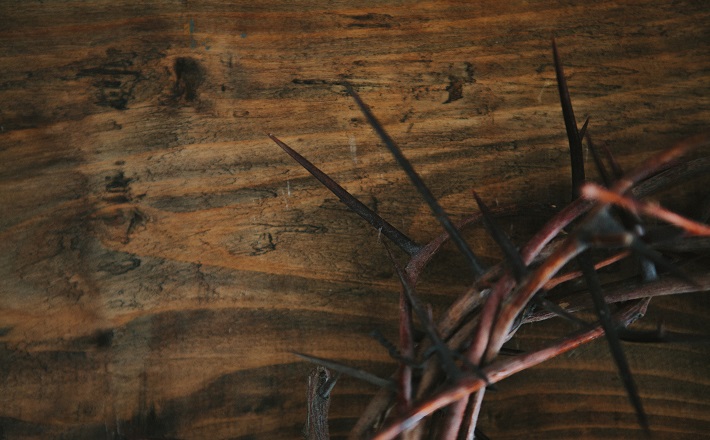Commentary on John 18:1—19:42
Preachers have much to work with in the lectionary’s Good Friday reading — two full chapters from the Gospel of John!1
John’s account of the first Good Friday begins in John 18 with Jesus and his disciples crossing, at night, the Kidron Valley east of Jerusalem, in order to reach a garden on the other side. In John, it is an anonymous place, though Matthew and Mark call it the garden Gethsemane. At the end of John 19, the account of the day concludes with Jesus’ body being laid to rest on the eve of the Sabbath (verse 31), in a place near to where he had been crucified, in a new tomb hewed out within another garden. Gardens and darkness frame Jesus’ last day in John.
Gardens now and then
When we think of “gardens” today we often imagine a patch of ground in someone’s backyard where flowers and vegetables sprout up. Of course, people in ancient Judea appreciated the beauty of flowers. They also often grew vegetables in areas near their homes in order to supplement the staples of their diet — grains (for bread and beer), olives (for olive oil), grapes (for raisins and wine). However, the term “garden” in the ancient world does not carry these connotations.
Ancient gardens were, by contrast, more akin to what we know today as parks. Not the sort of park that has baseball diamonds and basketball courts, but those with a refreshing fountain in the middle and footpaths lined with trees, places where people might calmly stroll or picnic. Ancient parks were more like that: spaces where pools of water could be found to refresh oneself and to water intentionally planted trees and shrubs. They were to be places of beauty where the body and spirit of visitors could be refreshed or restored.
Eden, paradise, is of course the archetypal garden in the Bible. Yet like the divine King in Genesis 2, monarchs throughout the ancient Near East also were renowned for being “gardeners,” for constructing magnificent gardens — Nebuchadnezzar’s “hanging gardens” in Babylon surely being the most famous. Among his other accomplishments Qoheleth, the Solomon-like figure of the book of Ecclesiastes, also recounts his building of a garden: “I made myself gardens and parks, and planted in them all kinds of fruit trees. I made myself pools from which to water the forest of growing trees.” (Ecclesiastes 2:5-6)
A tale of two gardens
It is not surprising then that a tomb — someone’s “final resting place” — like the one we read of in John 18 might have been carved out in a garden; nor is it anything extraordinary that Jesus would be “laid to rest” in such a peaceful and restorative place. Even today cemeteries are often tranquil, garden-like locations. What’s more, the calming and refreshing nature of ancient gardens, like the one where Jesus was interred, may subtly anticipate Jesus’ resurrection and the manner in which he will restore his followers to faith and peace.
It is, however, deeply ironic that the garden — the place that Jesus and his disciples knew well to be a place of retreat and restoration (“Jesus often met there with his disciples”, John 18:2) — would become the scene of a military and police action, and of violent resistance. As John 18 tells us “Judas brought a detachment of soldiers together with police from the chief priests and the Pharisees and they came there with lanterns and torches and weapons.” The tranquil darkness of night in the garden is interrupted by lurching shadows and shafts of light, the clamoring of soldiers, and the clanging of their iron armaments. At this moment, Peter meets the threat of violence with his own violence and is rebuked by Jesus:
“Then Simon Peter, who had a sword, drew it, struck the high priest’s slave, and cut off his right ear. The slave’s name was Malchus. Jesus said to Peter, ‘Put your sword back into its sheath. Am I not to drink the cup that the Father has given me?’” (John 18:10-11)
Both the Garden of Gethsemane and the tomb-garden occupy important places in the Christian theological imagination. One is the site of Jesus’ anguish over his impending death; the other is the place of his rising again to life. The tomb-garden is perhaps the one we prefer to remember, though preachers of John 18-19 might also recall with their congregations the other one too, especially on Good Friday.
With Jesus in the gardens
Many of us may be familiar with the protestant hymn, “I Come to the Garden Alone.” For some, the hymn’s lyrics are too sentimental and run the risk of leading the faithful into an overly sentimentalized and personalized understanding of the Christian life. It’s emphasis on an intimate, personal relationship with Jesus may make us forgetful of God’s call to join in the construction of a world of justice and mercy, the work of what Jews call the Tikkun Olam, the repairing of the world.
Yet the prominent place the hymn gives to the peace and tranquility that the individual believer might find in relationship with Jesus is a powerful and legitimate message of good news. When we today, in the imagination of faith, “come to the Garden alone,” the possibility of a genuine encounter with the risen Christ, like that which Mary Magdalene experienced on the first Easter (John 20:1), is open to us too. The hymn points us to a Christ who accepts us fully and promises to always to be with us: “He walks with me and talks with me and tells me I am his own.”
The garden of the hymn, however, is the garden of Easter mourning. But what of the garden of Good Friday night? Perhaps in knowing well that we stand firmly in the tomb-garden with the risen Jesus, we can also on Good Friday find our way back to Gethsemane and the Jesus who is with us there.
In Gethsemane we are reminded of Jesus’ suffering and sacrifice pro nobis, “for us” — but not merely in the sense that he has taken upon himself our individual sin and guilt. We are also reminded that violence and viciousness in our world is often quite a lot bigger than any one of us. It is not merely the sin and viciousness of individuals from which our world needs saving. Judas, the individual, betrayed Jesus, yes. But the violence and institutions of empire put him to death and today continue to rupture the tranquility of all our gardens.
On Easter, Jesus will indeed be raised to life and meet us in the tomb-garden. On Good Friday, by standing in the garden of Gethsemane with Jesus, Judas, Peter, the soldiers and all the rest, preachers can remind us fully of why he was killed.
Note:
1. This same commentary can be read in Spanish here.


March 30, 2018